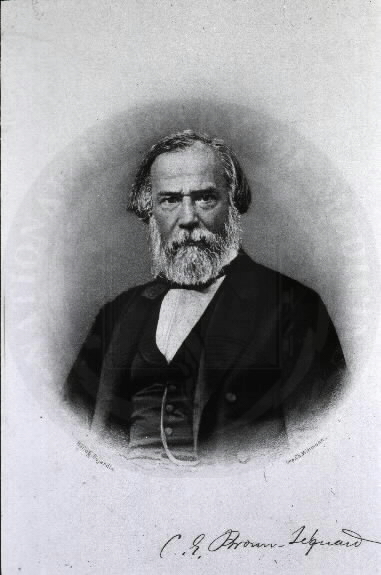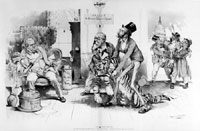 The impact of Brown-Sequard's 'rejuvenation' was profound. In 1889, when
he made public the results of his self-injections, he was a scientist
of international stature and a member of the prestigious French Academy
of Sciences. Moreover, he was 72 years old, near the end of a distinguished
career that included major contributions to neuroscience and adrenal function.
He was heir apparent to Claude Bernard's chair of medicine at the College
de France.
The impact of Brown-Sequard's 'rejuvenation' was profound. In 1889, when
he made public the results of his self-injections, he was a scientist
of international stature and a member of the prestigious French Academy
of Sciences. Moreover, he was 72 years old, near the end of a distinguished
career that included major contributions to neuroscience and adrenal function.
He was heir apparent to Claude Bernard's chair of medicine at the College
de France.

|
| click to enlarge |
According to one authority, within a year of the Paris presentation,
more than 12,000 physicians were administering the extract to their
patients (Hansen,
Bull.Hist.Med., 1999). The dramatic self-experimentation and resulting
zealous adoption of 'rejuvenation' by many physicians earned wide reportage
in a skeptical lay press, stimulating songs, comic poems, satirical
writings, and political caricatures.
 A century
later, scientists in Australia attempted to repeat the extraction of
male hormones from dog testes, following the methods published by Brown-Sequard
in his original work. Testosterone concentrations of the extract were
measured by radio-immunoassay. The Australians found that each of the
Brown-Sequard injections would have contained only about 100 ng of testosterone,
whereas daily testosterone secretion in man is about 6 mg. Further,
the testis does not store testosterone, but releases the hormone upon
synthesis into the systemic circulation; thus extracts from the testis
would not be expected to be particularly rich in testosterone. The authors
conclude, A century
later, scientists in Australia attempted to repeat the extraction of
male hormones from dog testes, following the methods published by Brown-Sequard
in his original work. Testosterone concentrations of the extract were
measured by radio-immunoassay. The Australians found that each of the
Brown-Sequard injections would have contained only about 100 ng of testosterone,
whereas daily testosterone secretion in man is about 6 mg. Further,
the testis does not store testosterone, but releases the hormone upon
synthesis into the systemic circulation; thus extracts from the testis
would not be expected to be particularly rich in testosterone. The authors
conclude,
"…the placebo effect can be powerful, even in
a highly educated physician (Cussons,
Med.J.Aust., 2002)."
 |
| Hypodermic Syringe, c.1880 |
Brown-Sequard, C. Note on the effects produced in man by subcutaneous
injections of a liqueid obtained from the testicles of animals (Lancet
2: 105, 1889).
|
 The impact of Brown-Sequard's 'rejuvenation' was profound. In 1889, when
he made public the results of his self-injections, he was a scientist
of international stature and a member of the prestigious French Academy
of Sciences. Moreover, he was 72 years old, near the end of a distinguished
career that included major contributions to neuroscience and adrenal function.
He was heir apparent to Claude Bernard's chair of medicine at the College
de France.
The impact of Brown-Sequard's 'rejuvenation' was profound. In 1889, when
he made public the results of his self-injections, he was a scientist
of international stature and a member of the prestigious French Academy
of Sciences. Moreover, he was 72 years old, near the end of a distinguished
career that included major contributions to neuroscience and adrenal function.
He was heir apparent to Claude Bernard's chair of medicine at the College
de France.


 A century
later, scientists in Australia attempted to repeat the extraction of
male hormones from dog testes, following the methods published by Brown-Sequard
in his original work. Testosterone concentrations of the extract were
measured by radio-immunoassay. The Australians found that each of the
Brown-Sequard injections would have contained only about 100 ng of testosterone,
whereas daily testosterone secretion in man is about 6 mg. Further,
the testis does not store testosterone, but releases the hormone upon
synthesis into the systemic circulation; thus extracts from the testis
would not be expected to be particularly rich in testosterone. The authors
conclude,
A century
later, scientists in Australia attempted to repeat the extraction of
male hormones from dog testes, following the methods published by Brown-Sequard
in his original work. Testosterone concentrations of the extract were
measured by radio-immunoassay. The Australians found that each of the
Brown-Sequard injections would have contained only about 100 ng of testosterone,
whereas daily testosterone secretion in man is about 6 mg. Further,
the testis does not store testosterone, but releases the hormone upon
synthesis into the systemic circulation; thus extracts from the testis
would not be expected to be particularly rich in testosterone. The authors
conclude,
